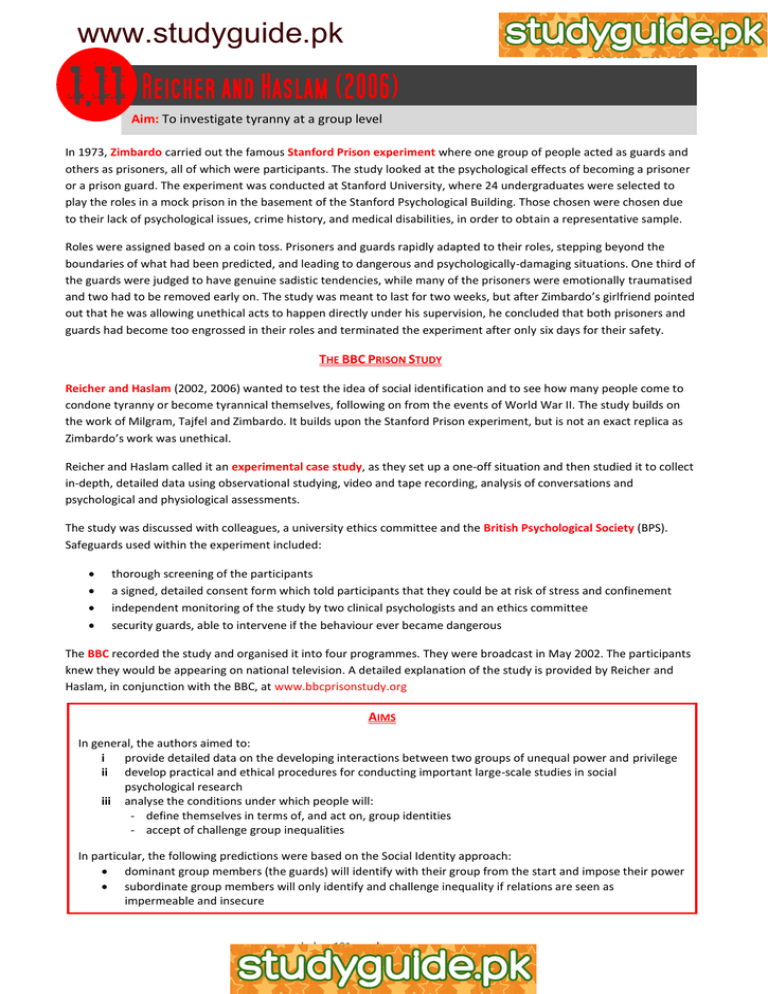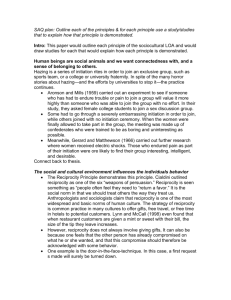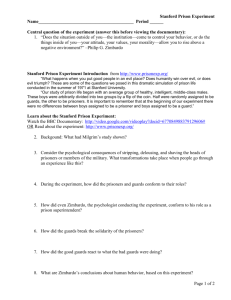Aim:
advertisement

www.studyguide.pk Aim: To investigate tyranny at a group level In 1973, Zimbardo carried out the famous Stanford Prison experiment where one group of people acted as guards and others as prisoners, all of which were participants. The study looked at the psychological effects of becoming a prisoner or a prison guard. The experiment was conducted at Stanford University, where 24 undergraduates were selected to play the roles in a mock prison in the basement of the Stanford Psychological Building. Those chosen were chosen due to their lack of psychological issues, crime history, and medical disabilities, in order to obtain a representative sample. Roles were assigned based on a coin toss. Prisoners and guards rapidly adapted to their roles, stepping beyond the boundaries of what had been predicted, and leading to dangerous and psychologically-damaging situations. One third of the guards were judged to have genuine sadistic tendencies, while many of the prisoners were emotionally traumatised and two had to be removed early on. The study was meant to last for two weeks, but after Zimbardo’s girlfriend pointed out that he was allowing unethical acts to happen directly under his supervision, he concluded that both prisoners and guards had become too engrossed in their roles and terminated the experiment after only six days for their safety. THE BBC PRISON STUDY Reicher and Haslam (2002, 2006) wanted to test the idea of social identification and to see how many people come to condone tyranny or become tyrannical themselves, following on from the events of World War II. The study builds on the work of Milgram, Tajfel and Zimbardo. It builds upon the Stanford Prison experiment, but is not an exact replica as Zimbardo’s work was unethical. Reicher and Haslam called it an experimental case study, as they set up a one-off situation and then studied it to collect in-depth, detailed data using observational studying, video and tape recording, analysis of conversations and psychological and physiological assessments. The study was discussed with colleagues, a university ethics committee and the British Psychological Society (BPS). Safeguards used within the experiment included: thorough screening of the participants a signed, detailed consent form which told participants that they could be at risk of stress and confinement independent monitoring of the study by two clinical psychologists and an ethics committee security guards, able to intervene if the behaviour ever became dangerous The BBC recorded the study and organised it into four programmes. They were broadcast in May 2002. The participants knew they would be appearing on national television. A detailed explanation of the study is provided by Reicher and Haslam, in conjunction with the BBC, at www.bbcprisonstudy.org AIMS In general, the authors aimed to: i provide detailed data on the developing interactions between two groups of unequal power and privilege ii develop practical and ethical procedures for conducting important large-scale studies in social psychological research iii analyse the conditions under which people will: - define themselves in terms of, and act on, group identities - accept of challenge group inequalities In particular, the following predictions were based on the Social Identity approach: dominant group members (the guards) will identify with their group from the start and impose their power subordinate group members will only identify and challenge inequality if relations are seen as impermeable and insecure www.aspsychology101.wordpress.com www.studyguide.pk INDEPENDENT VARIABLES 1 2 3 4 DEPENDENT VARIABLES RECORDED Amount of power (guard vs prisoner) Group permeability (before vs after being told it was no longer possible for prisoners to become guards on day three) Legitimacy (before vs after being told there were in fact no psychological differences depending on whether the participants became prisoners or guards) – this variable was not tested Cognitive alternatives – this means that someone sees there is a different way of thinking about a situation, this was measured by looking at the introduction of a new prisoner, who had been a trade union official, as the researchers thought he would provide ideas on how to improve conditions for the prisoners and negotiate more effectively 5 6 7 Social variables: social identification, awareness of cognitive alternatives, right-wing authoritarianism Organisational variables: compliance with rules Clinical variables: self-efficacy, depression PARTICIPANTS 15 men, randomly divided into two groups of 5 guards and 10 prisoners, selected as being pro-social and well-adjusted (by psychometric testing, independent clinical assessment and character references), of a variety of ages and backgrounds, from 332 applications recruited from a national press advertisement Participants spent eight days under constant video surveillance in a purpose-built, controlled institutional environment resembling a prison that aimed to create “inequalities between groups that were real to the participants.” Prisoners had their heads shaved and had basic uniforms (T-shirts with a 3-digit number, loose trousers and sandals), and basic food and living conditions in lockable 3-person cells. Guards had better uniforms, food and accommodation. They also had control over the keys and resources to use as rewards or punishments. They were shown the prison timetable/chores and had complete freedom in how they implemented their responsibility for the smooth-running of the prison (with the exception of physical violence). On day 5, another prisoner was added. He was a trade union official who the researchers hoped would provide ideas on how to improve the prisoners’ conditions. Prisoners were told that one of them would be promoted on day 3 to become a guard. This created a condition of high group permeability and high fairness. However, on day 3 after the promotion, prisoners were told there would be no more promotion, creating a condition of low permeability. Three days later, they were told that there was in fact no difference in the characters of the prisoners and guards. This created a condition of low fairness. Each morning all participants rated their identification with their own group (prisoner or guard) and with the other group. FINDINGS For the first three days the prisoners were dissatisfied with their living conditions but focused on being promoted to guard rather than working together to improve their conditions. For the first two days while group permeability was high the guards identified more strongly with their group than the prisoners did. However, once the prisoner was promoted on day 3 and the group permeability dropped, the group identity scores of prisoners outstripped those of the guards, remaining higher for the rest of the study. On day 4 three prisoners defied three guards, demanding better food. The guards could not agree how to respond, so came off worse in the confrontation. The prisoners’ confidence www.aspsychology101.wordpress.com www.studyguide.pk increased steadily and on day 6 they broke out of their cells and occupied the guards’ quarters. Prisoners and guards then decided to form a commune and govern together. This initially worked well, however four participants became dissatisfied and proposed a new and very harsh regime. The study was halted at this point to avoid the possibility of violence. WHAT SOCIAL IDENTITY THEORY WOULD SAY ABOUT THE EXPERIMENT The dominant group (the guards) quickly showed high levels of group identification. The subordinate group (the prisoners) had low levels of identification as long as group permeability was high, but this increased sharply as group permeability was reduced. Collective action followed quickly on day 4. By day 6 this was successful and the inequalities between groups were scrapped. However, the new equal regime soon broke down. These findings are as predicted by social identity theory. EVALUATION Strengths Ethics: there was competence, in the way that the experiment had the approval of the BPS, among other sources; the participants knew what the study involved and about the TV cameras, so were not being deceived, and also had informed consent relating to the study; all participants were given the full right to withdraw at any time, and there were other officials there to withdraw them if it became necessary; and all participants were fully debriefed following the experiment. This study was much more ethical than Zimbardo’s original study, and was just ethical in general. Triangulation of results was possible: if data agrees the findings are likely to be reliable and the behaviour being measured was more likely to be real. Weaknesses It was not possible to draw cause-and-effect conclusions from the experiment, as behaviour was being observed over a period of time, reactions to individual tasks and events weren’t being monitored in this study. Also, the presence of the television cameras may have affected their behaviour, making it an unrealistic situation, and making the results possibly less valid. www.aspsychology101.wordpress.com





